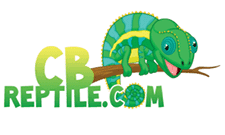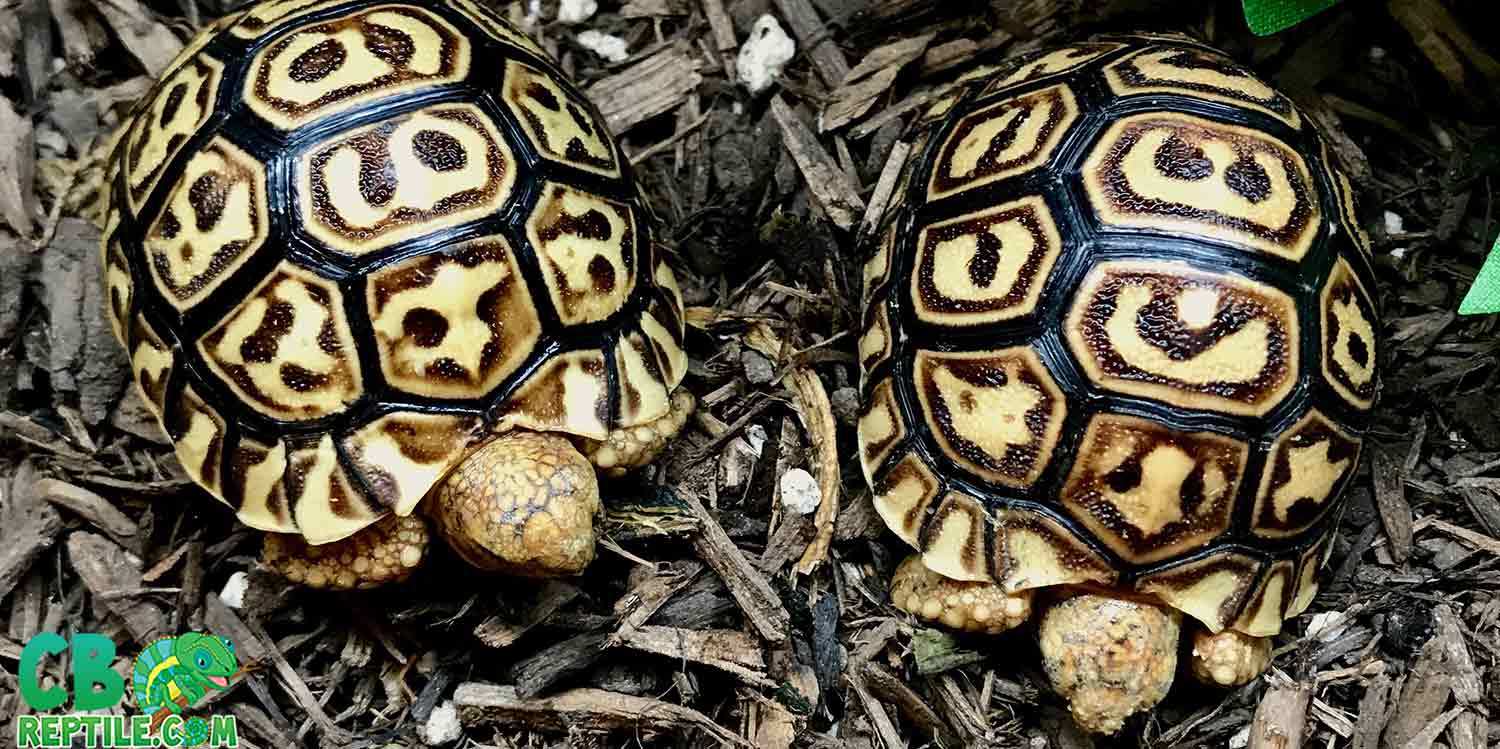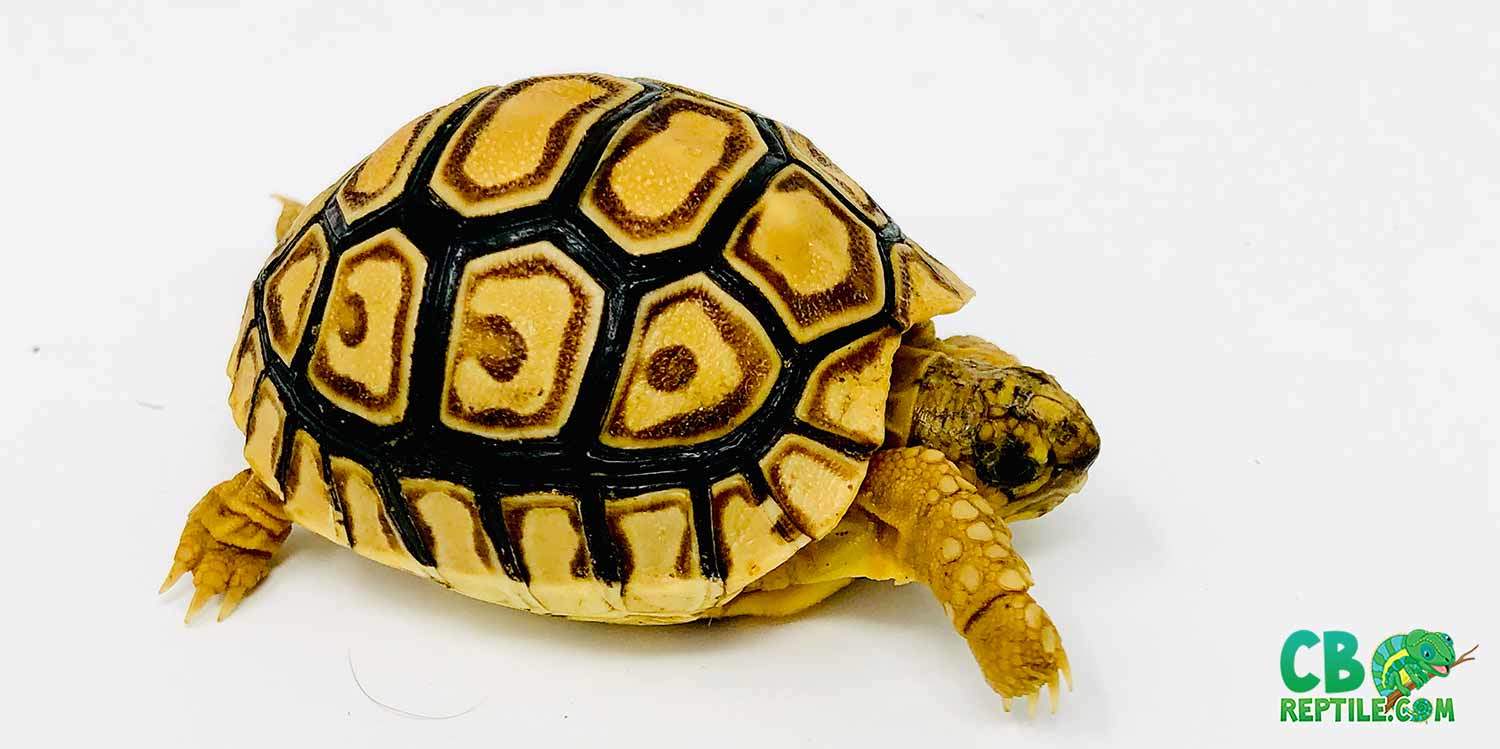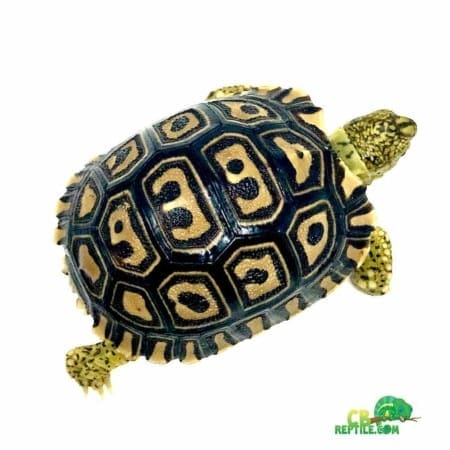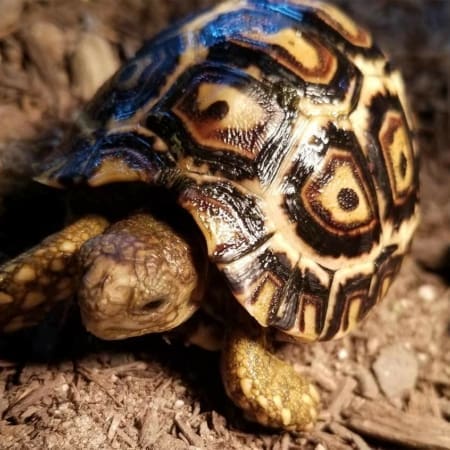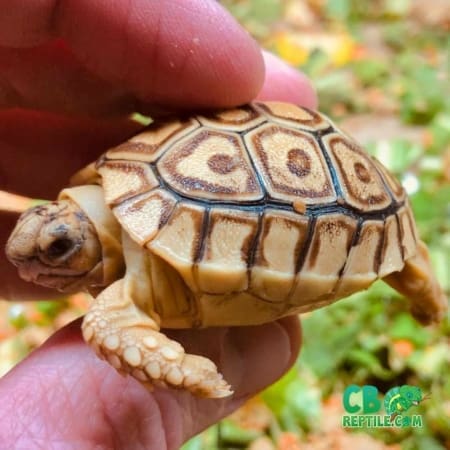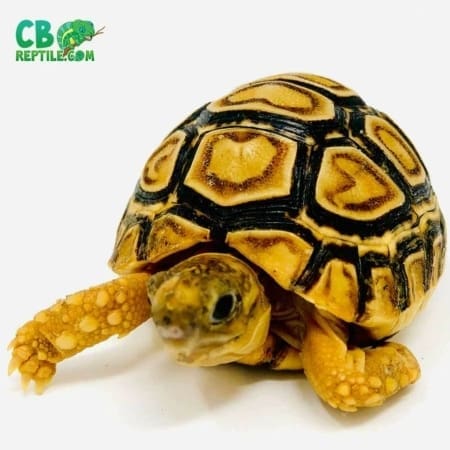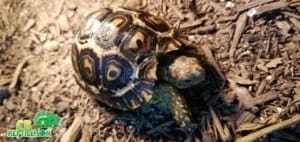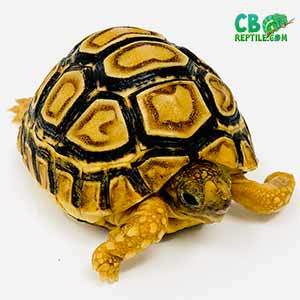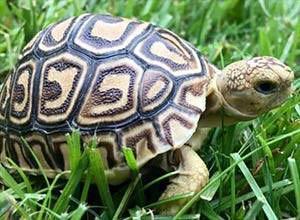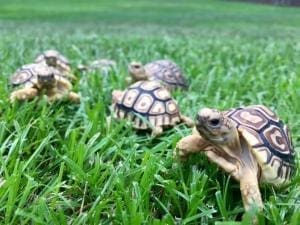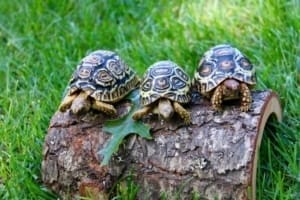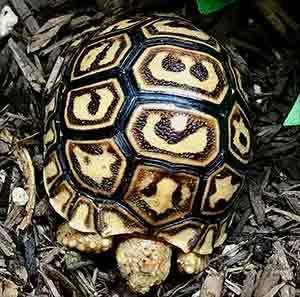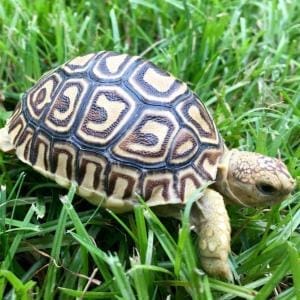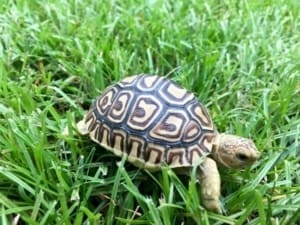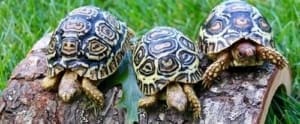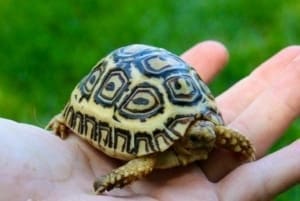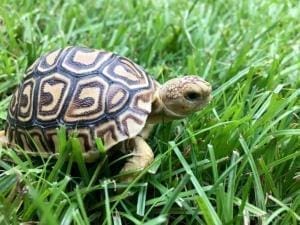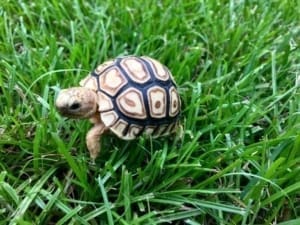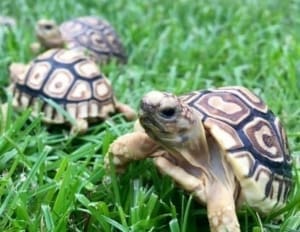Baby leopard tortoise for sale
Leopard tortoises are some of the more popular tortoises as far as collectors and tortoise enthusiasts go. They are friendly, beautiful, can learn to eat from your hand and are very docile and relaxed as far as temperament. Leo torts will live up to 100 years of age and can make great additions to your reptile family for decades to come. Leopard tortoises are often considered the perfect medium-sized tortoise for sale.
Baby leopard tortoises all the way up to about 18 months old, should be raised in high humidity environments. We soak our baby leopard tortoises daily and raise them at 75% humidity to ensure perfect shell growth. Raising your baby leopard tortoise or juvenile leopard tortoise with higher humidity also will allow them to grow much more rapidly and thrive as a whole. Contrary to popular belief, leopard tortoises though from Africa, do well in humid micro-climates when young.
Feeding your new baby leopard tortoise for sale high-quality food is key!
Most importantly, their primary diet is romaine, collard, mustard greens, yellow squash, dandelion greens, spring mix, and Mazuri tortoise food. If you’re considering a pair, consider female and female so there is not overbreeding over they are mature at about 5-6 years of age. Leopard tortoises can reach up to 14-15″ and Giant South African leopard tortoise for sale up to 18-24″. Also consider overall size, that most fall in the 16-18″ range. Giant South African leopard tortoises (pardalis pardalis) are the most personable and outgoing of all the species of leopard tortoise for sale.
Leopard Tortoise for sale
We have some fantastic leopard tortoises for sale! CB Reptile offers a wide variety of leopard tortoise for sale including baby leopard tortoise for sale. Also, we offer well started 6-month-old baby leopard tortoise, yearling leopard tortoises for sale. Lastly, we also offer adult leopard tortoise for sale online.
baby leopard tortoise for sale
As leopard tortoise breeders, we work with both traditional pardalis babcocki leopard tortoise from northern and eastern African regions as well the rarer and highly sought after giant South African leopard tortoise. The giant South African leopard tortoise is also known as Pardalis Pardalis for sale. The Giant South African leopard tortoises for sale are a bit larger, with a milder domed shell and darker, higher pigmented markings. Giants also are known for their outgoing personality and are a bit more friendly than the traditional leopard tortoise hatchlings.
Before purchasing your new pet leopard tortoise for sale, please make sure you find an experienced captive bred leopard tortoise breeder and do your homework researching proper care for both the more common Pardalis Babcocki East African leopard tortoise as well as Giant South African leopard tortoise care.
Our biolgist has provided a detailed Sulcata tortoise care guide that will cover the following topics:
- Leopard tortoise care
- leopard tortoise habitat
- baby leopard tortoise diet
- leopard tortoise humidity
- leopard tortoise substrate
- African leopard tortoise temperature
- leopard tortoise size
- pet leopard tortoise lifespan
- leopard tortoise for sale
- giant leopard tortoise
- baby leopard tortoise
- African Sulcata tortoise for sale
- Albino Sulcata tortoise
- Ivory tortoise
- All species of tortoise for sale
- other species of Giant tortoise for sale
Leopard Tortoises for sale
The leopard tortoise (Stigmochelys pardalis) is a brightly colored, high-domed, medium-to-large tortoise. It has been popular in the pet trade for many years. Found from Sudan in the northern part of Africa to the Cape in South Africa, leopard tortoises typically inhabit savannas and are not seen in humid rain forests or dry deserts. This species is currently known by two subspecies, Stigmochelys pardalis pardalis and Stigmochelys pardalis babcocki. For many years, it was included in the genus Geochelone, but it is now considered its own genus.
There are two recognized leopard tortoise subspecies: the southern (S. p. pardalis) and the northern (S. p. babcocki). Because range of the latter within Africa is Sudan, east to Ethiopia and Somalia, down the eastern side of Africa to the Southern Cape and back up the western side to Angola. Stigmochelys p. pardalis is limited to the southern part of South Africa and Namibia. Lastly, two subspecies will readily interbreed if housed together, producing viable offspring.
Baby leopard tortoises for sale
There is a lot of color variation in leopard tortoises for sale. Also, they typically have a golden carapace covered with black flecking or spots. Because each pattern is like a fingerprint and unique to that baby leopard tortoise. Secondly, the pardalis subspecies is known to be a darker form, less domed, and grows to a larger size. Lastly, leopard tortoise hatchlings can be distinguishable from babcocki hatchlings. Because they typically (not always, however) have two spots per scute, and pardalis babcocki hatchlings for sale have one or none.
Leopard tortoises for sale generally inhabit dry grassland areas and are known to occur in low densities throughout their large range. They are considered a food item by many indigenous African people and some populations are vulnerable. Although only two subspecies are recognized, there is a great deal of variability in size. Also, there is a great variety in, patterns, and even shapes within localized populations, with possible undescribed subspecies existing.
from baby to Juvenile Leopard tortoise
Adult leopards are high-domed tortoises that range in length from 10 to 21 inches, and which can weigh up to 45 pounds. Stigmochelys p. babcocki is the most readily available leopard tortoise in the pet trade, with males averaging 10 inches and females 12 to 16 inches. In contrast, there are reports of exceptionally large specimens from South Africa and Ethiopia that weigh well over 70 pounds.
Only Buy Captive-Bred Baby leopard tortoise for sale
Large leopard tortoises have a difficult time adjusting to new environments, but baby leopard tortoise hatchlings for sale seem to be able to adjust to a wide range of conditions. Most of the leopard tortoises imported from the wild years ago had a very difficult time adjusting to their new homes, and with the stress of importation, most did not survive. Captive-hatched leopard tortoises have a very high survival rate. Because they can adjust, they have even adjusted to the dry deserts of Arizona and the humid summers of northern Virginia when protected from extreme heat and cold.
We recommend purchasing a baby leopard tortoise for sale that is well started at 6 months old, or a yearling. Older, captive-raised tortoises will usually adjust to a new home, but it may take several months or more. Most importantly, a baby leopard tortoise for sale should have bright eyes, a good weight and be active when picked up. Lastly, your setup should be ready for your new acquisition before you bring it home.
Leopard for sale – baby Leopard tortoise diet
We feed our baby through juvenile leopard tortoises for sale a high-fiber diet daily. Adult leopard tortoises for sale are allowed to graze on a more natural diet of Bermuda grass and will need less supplemental foods. I offer dried grasses such as timothy hay or a Bermuda grass mix with some alfalfa to both indoor and outdoor tortoises. As a leopard tortoise breeder, we feed a variety of supplemental foods including greens such as romaine, dandelions or a high-quality spring mix without spinach.
Also, try to avoid foods that are high in oxalic acids, such as chard, spinach and rhubarb. Oxalic acids bind with calcium, which prevents the tortoise from absorbing the calcium. As leopard tortoise breeders, we do add vegetables such as zucchini, carrots, bell peppers and squashes. Lastly, leopard tortoises also like grape and mulberry tree leaves, as well as Opuntia cactus pads and succulents. I avoid any fruits, citrus or acidic vegetables such as tomatoes.
Greens should be dusted with a high-quality vitamin powder and calcium powder once a week. For hatchlings kept indoors, a calcium powder with D3 should be used. Many tortoise keepers also add cuttlebone to their tortoise enclosures, which the tortoises will chew on, receiving additional calcium in the process. A commercial herbivore tortoise diet can also be offered to supplement your tortoise’s primary diet of grasses.
Baby Leopard tortoise for sale – food list
Your baby leopard tortoise for sale will grow around 2 to 4 inches a year, depending on temperature and diet, so plan on providing a larger enclosure as your tortoise grows. Start with something simple, like an aquarium (a breeder tank has more floor space), tortoise table or plastic box measuring at least 16 inches wide, 24 inches long and 4 or more inches tall for one or two hatchlings. As the tortoise grows, you can move it to a plastic tub. Because there are many options, you can choose things like a concrete mixing tub. Also, consider a tub specifically made for turtles and tortoises. Once the tortoise is 4 to 6 inches, it should be moved to an outdoor enclosure if possible.
baby through juvenile leopard tortoise habitat size
Provide as much room as possible. Generally, about 150 square feet is suitable for one adult tortoise and an additional 75 square feet of area for each additional tortoise. If the grass in their yard is holding up to their grazing, you have sufficient room. If not, you should enlarge the enclosure or reduce the number of tortoises. Be sure there are hiding places and that shade is available at all times. If the tortoise can’t get out of the sun, it will overheat and die.
Let your baby leopard tortoise for sale
adjust to your home!
Your baby leopard tortoise may be shy and not very active until it adjusts to its new home. You can help it adjust by feeding it the same time every day. After it has had time to warm up, place the tortoise directly in front of its food. In the wild, leopard tortoises are a grazing species. If possible, a grass yard is recommended for your tortoise.
If a grass yard is not available for all or part of the year, their diet can be high-quality greens. Greens can include things such as a spring salad mix, and a good commercial tortoise diet. Because the tortoise does not require a lot of protein, offer a diet with 15 percent protein. Hatchlings require 15 to 20 percent of their diet be of protein. Include grated carrots, grass clippings.
Additonally, hatchling leopard tortoise for sale enjoy (free of fertilizer and pesticides), dandelions, chopped peppers, cilantro, rose petals, hibiscus flowers. Lastly, you can alos feed your baby leopard tortoise spineless prickly pear cactus, nasturtiums, and grape leaves.
Leopard tortoise food list continued…
Avoid feeding dog or cat food, or large amounts of fruit. A little fruit is fine, but only offer it on rare occasions, no more than once or twice a month, as a treat. Too much fruit will result in runny stools and provide a great place for parasites to thrive in the tortoise’s gut. Fruit is also lacking in protein. The protein contains amino acids, which are the building blocks for a hard and healthy shell. Lastly, for the baby leopard tortoise for sale, most of the required protein can be obtained from quality greens. Because many of the greens contain about 15 to 20 percent protein.
Baby leopard tortoises for sale will thrive in captivity and become very personable pets. Secondly, we highly recommend them if you can provide proper care. Most importantly, leopard tortoises for sale can provide many years of enjoyment for their owners, whom they will likely outlive. Much of this information was written by one of the best authorities on Leopard tortoises in the world, Richard Fife.
